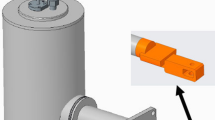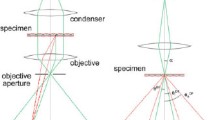Abstract
Transmission electron microscopy (TEM) is the main technique used to study the ultrastructure of biological samples. Chemical fixation was considered the main method for preserving samples for TEM; however, it is a relatively slow method of fixation and can result in morphological alterations. Cryofixation using high-pressure freezing (HPF) overcomes the limitations of chemical fixation by preserving samples instantly. Here, we describe our HPF methods optimized for visualizing Candida auris at the ultrastructural level.
Access this chapter
Tax calculation will be finalised at checkout
Purchases are for personal use only
Similar content being viewed by others
References
Sabatini DD, Bensch K, Barrnett RJ (1963) Cytochemistry and electron microscopy. The preservation of cellular ultrastructure and enzymatic activity by aldehyde fixation. J Cell Biol 17:19–58. https://doi.org/10.1083/jcb.17.1.19
Sabatini DD, Miller F, Barrnett RJ (1964) Aldehyde fixation for morphological and enzyme histochemical studies with the electron microscope. J Histochem Cytochem 12:57–71. https://doi.org/10.1177/12.2.57
Giddings TH, O’Toole ET, Morphew M et al (2001) Using rapid freeze and freeze-substitution for the preparation of yeast cells for electron microscopy and three-dimensional analysis. Methods Cell Biol 67:27–42. https://doi.org/10.1016/s0091-679x(01)67003-1
Sawaguchi A (2013) Advantages of high-pressure freezing technique for fine structural electron microscopy. Plant Morphol 25:7–10
Korogod N, Petersen CCH, Knott GW (2015) Ultrastructural analysis of adult mouse neocortex comparing aldehyde perfusion with cryo fixation. eLife 4:e05793. https://doi.org/10.7554/eLife.05793
Steinbrecht RA, Müller M (1987) Freeze-substitution and freeze-drying. In: Cryotechniques in biological electron microscopy. Springer, Berlin, Heidelberg, pp 149–172
Kellenberger E, Johansen R, Maeder M et al (1992) Artefacts and morphological changes during chemical fixation. J Microsc 168(Pt 2):181–201
O’Donnell KL, McLaughlin DJ (1984) Ultrastructure of meiosis in ustilago maydis. Mycologia 76:468–485
Hammill TM (1974) Septal pore structure in trichoderma saturnisporum. Am J Bot 61(7):767–771. https://doi.org/10.1002/j.1537-2197.1974.tb12299.x
Collinge AJ, Markham P (1982) Hyphal tip ultrastructure of Aspergillus nidulans and Aspergillus giganteus and possible implications of woronin bodies close to the hyphal apex of the latter species. Protoplasma 113:209–213. https://doi.org/10.1007/BF01280909
Dahl R, Staehelin LA (1989) High pressure freezing for the preservation of biological structure: theory and practice. J Electron Microsc Tech 13:165–174. https://doi.org/10.1002/jemt.1060130305
McDonald K (1999) High-pressure freezing for preservation of high resolution fine structure and antigenicity for immunolabelling. In: Nasser Hajibagheri MA (ed) Electron microscopy methods and protocols. Humana Press, Totowa, pp 77–97
Moor H (1987) Theory and practice of high pressure freezing. In: Cryotechniques in biological electron microscopy. Springer-Verlag, Heidelberg, pp 175–191
Shimoni E, Muller M (2008) On optimizing high-pressure freezing: from heat transfer theory to a new microbiopsy device. J Microsc 192:236–247
Murray S (2008) Chapter 1 high pressure freezing and freeze substitution of Schizosaccharomyces pombe and Saccharomyces cerevisiae for TEM. In: Allen T (ed) Introduction to electron microscopy for biologists. Elsevier, Manchester, pp 3–17
Nicolas M-T, Bassot J-M (1993) Freeze substitution after fast-freeze fixation in preparation for immunocytochemistry. Microsc Res Tech 24:474–487
Villiger W (1991) Lowicryl resins. In: Hayat M (ed) Colloidal gold: principles, methods and applications. Academic Press, New York, pp 59–71
Newman G, Hobot J (1993) Handling resin blocks. In: Resin microscopy and on-section immunocytochemistry. Springer, Berlin, Heidelberg, pp 101–105
Hoch H (1986) Freeze-substitution of fungi. In: Aldrich H, Todd W (eds) Ultrastructure techniques for microorganisms. Springer, Boston, pp 183–212
Mims CW, Celio GJ, Richardson EA (2003) The use of high pressure freezing and freeze substitution to study host-pathogen interactions in fungal diseases of plants. Microsc Microanal 9:522–531. https://doi.org/10.1017/S1431927603030587
Walker LA, Gow NA, Munro CA (2013) Elevated chitin content reduces the susceptibility of Candida species to caspofungin. Antimicrob Agents Chemother 57:146–154
Walker L, Sood P, Lenardon MD et al (2018) The viscoelastic properties of the fungal cell wall allow traffic of ambisome as intact liposome vesicles. mBio 9:1–15. https://doi.org/10.1128/mBio.02383-17
Walker CA, Gomez BL, Mora-Montes HM et al (2010) Melanin externalization in Candida albicans depends on cell wall chitin structures. Eukaryot Cell 9:1329–1342
Gow NA, Netea MG, Munro CA et al (2007) Immune recognition of Candida albicans beta-glucan by dectin-1. J Infect Dis 196:1565–1571
Acknowledgement
The authors acknowledge the Microscopy and Histology Core Facility at the University of Aberdeen for expert assistance.
Author information
Authors and Affiliations
Corresponding author
Editor information
Editors and Affiliations
Rights and permissions
Copyright information
© 2022 The Author(s), under exclusive license to Springer Science+Business Media, LLC, part of Springer Nature
About this protocol
Cite this protocol
Milne, G., Walker, L.A. (2022). High-Pressure Freezing and Transmission Electron Microscopy to Visualize the Ultrastructure of the C. auris Cell Wall. In: Lorenz, A. (eds) Candida auris. Methods in Molecular Biology, vol 2517. Humana, New York, NY. https://doi.org/10.1007/978-1-0716-2417-3_15
Download citation
DOI: https://doi.org/10.1007/978-1-0716-2417-3_15
Published:
Publisher Name: Humana, New York, NY
Print ISBN: 978-1-0716-2416-6
Online ISBN: 978-1-0716-2417-3
eBook Packages: Springer Protocols




